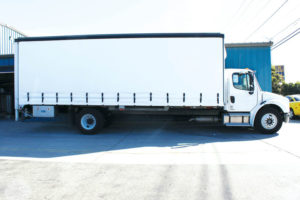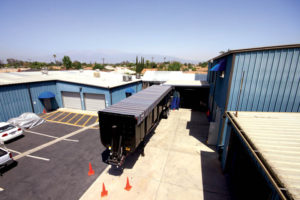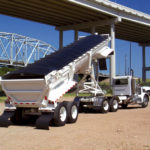Tarp manufacturers stay up to date with the
needs of the transportation industry.
By Janice Kleinschmidt
Some folks see a semitrailer and think of it as nothing more than an object to pass before the next exit. Tyler Birden sees an object of curiosity.
 “We are always climbing up on trucks and trailers to see what they have and what’s new,” says Birden, who owns Automatic Load Cover LLC with his father, John Birden. The Torrington, Conn.-based company has been manufacturing hydraulic cover systems for trucks and trailers since 2000 and two years ago began manufacturing tarps. “We are a small company. I like to spend time with customers and hear feedback,” Birden says.
“We are always climbing up on trucks and trailers to see what they have and what’s new,” says Birden, who owns Automatic Load Cover LLC with his father, John Birden. The Torrington, Conn.-based company has been manufacturing hydraulic cover systems for trucks and trailers since 2000 and two years ago began manufacturing tarps. “We are a small company. I like to spend time with customers and hear feedback,” Birden says.
“Manufacturing tarps,” he adds, “gives us greater quality control, more flexibility for delivery time and competitive pricing, as well as a variety of materials and options for customization.”
The company designs and sells hydraulic, locking-load cover systems. Ninety-nine percent of its business involves tarps for transportation. Since becoming a manufacturer, Automatic Load Cover has added a heavy-duty, 1000-denier, vinyl-coated mesh to its line.
“We use a lot of vinyl-coated mesh and a lot of 22-ounce solid-vinyl tarps,” Birden says. “We were getting what our vendors had and suggested that we have without knowing our specific application. Now that we are able to do it ourselves, we have gone to fabric shows in search of the latest and greatest material options and trends.”
Richard Cossette, owner and president of T.R.S. Industries Inc. in Fargo, N.D., expanded his company’s fabric offerings after one of its regular customers—a hauler of multiple food-grade products—requested a more slippery fabric for a roll tarp.
“They spent a lot of money washing tarps that were hard to clean because products were sticking to the fabric,” Cossette says. In conjunction with Seaman Corp., T.R.S. Industries came up with a solution called Supreme Clean: an 18-ounce, vinyl-coated nylon with an acrylic lacquer coating.
“The material we are hauling doesn’t stick to the tarp, so it’s a lot easier to clean,” says the client, Ken Foltz, co-owner of Foltz Trucking. “It saves us time and you don’t have the possibility of cross-contamination. And because they are thicker, they will have more longevity than normal tarps.”
After a little more than a year of using Supreme Clean tarps on 35 trailers in its fleet, the Detroit Lakes, Minn.-based company has ordered another 50 for new hopper-bottom trailers, even though the cost is about 10 percent higher than the price for tarps it previously bought.
“We feel, for the long run and everyday use, it’s worth the extra upfront cost,” Foltz says.
Maintaining an edge

“There have been a few fabrics that are new that have impacted our business, mainly in mesh fabrics,” says Clayton Edwards, owner of Edwards Canvas Inc. in Pauls Valley, Okla. “Vinyl-coated mesh has vastly improved—and that has increased our business because it lasts longer and we get better word-of-mouth advertising from truckers.”
What customers want in tarps, Edwards says, are longer life and good abrasion resistance. The transportation market accounts for about 60 percent of his company’s business and 55 percent of that is custom work. Inventory includes mesh and vinyl-coated PVC in a wide range of weights.
Automatic Load Cover is “always looking for wider, stronger and heavier material,” Birden says, noting that thicker fabrics hold up better and that having wider material aids in production.
“We prefer welding seams and hems over sewing them,” he adds. “Welding tarps allows for greater precision; we can get our tarps within 1/16th-inch square. The better they roll, the longer they last.”
His goal is to find fabrics that don’t require seams down the middle. “We struggled to find manufacturers willing to make them wide enough,” Birden says. “Now we get vinyl 126 inches wide. We also have trampoline fabric 155 inches wide, but it’s not weldable. We’re trying to find vinyl-coated, 10-ounce mesh in 840 denier, 12 feet wide that we can weld.
“Eliminating a seam not only increases productivity, but also can eliminate a potential failure point on tarps,” Birden adds. “That has increased our business tremendously.”

Cossette thinks using vinyl-coated nylon gives T.R.S. Industries an edge over its competition. “Everyone uses polyester,” he says. “Nylon is more expensive. It’s a little harder to work with, but we have used it for many years. Customers expect a fabric that’s going to give them good life. On a hopper-bottom trailer, three years is an average life; we’re getting four to five years.”
Ask Tim Cullins, owner of Cullins Truck Tarping Systems in Clements, Md., what trucking companies want and expect performance-wise in tarps and he’ll answer with a hint of a chuckle. “More than they can get,” he says. “They want a low price and high quality.”
“For larger fleets, the first thing they ask is about performance. ‘How is it going to last? Will it meet my needs?’ Then they ask, ‘What’s the price?’” Birden says. “Smaller fleets are more concerned with price alone.”
Bud Weisbart, vice president of A&R Tarpaulins Inc. in Fontana, Calif., offers a similar take on the marketplace. “You have many customers who are looking to satisfy the need to tarp and don’t care about anything but price. However, customers with whom we have worked for decades want quality,” he says.
Weisbart doesn’t use the word competition, in part because he thinks the market is larger than those in the industry currently serving it can tap. He will, however, articulate an A&R edge.
“What sets us apart is how we envision what our company is and what we are doing,” he says. “We look at this not as an approach to selling truck covers, but more as an approach to keeping truck drivers on the road. For example, we spend a lot of time repairing tarps. Many [tarp manufacturers] don’t want to tie up their shops doing repairs. If your vision is to keep drivers on the road, then you better do repairs.”
Fixes in the mix
Repairing tarps may not be especially lucrative compared to sales of new tarps, but, as Birden points out, “It goes a lot further than telling customers, ‘You have to throw it out and buy a new one.’”
While Automatic Load Cover offers repair services at its facilities, Birden also takes a heat gun and generator to weld tarps off-site, including tarps manufactured by the company’s competitors. “That helps us get our foot in the door and leads to other customers,” he says.
According to Cossette, repairs account for about 25 percent of T.R.S. Industries’ business. A backlog of semitrailers awaiting service in one of two installation/repair bays led to a recent building addition. “We had to move trailers in and out all the time,” he says. “We moved all our tarp manufacturing into the new addition, so we have nine bays.”
Cullins Truck Tarping offers both on- and off-site repair services in a roughly 40/60 ratio, depending mostly on how many customers in a given area need the service and whether customers are willing to pay the company’s off-site travel charge. “If I have one job 100 miles from here, they will bring it in instead of paying for travel,” Cullins says.

Edwards Canvas repairs tarps on vehicles off-site and also operates a delivery service to pick up tarps for in-house repairs. Most of A&R Tarpaulins’ repair work happens in its manufacturing facilities, but it also sells a proprietary SKP® Super Kwik Patch composed of a vinyl and acrylic fabric tape intended for emergency/on-the-road repairs.
Double Tuff Truck Tarps limits repairs to its facilities in Austin, Texas, but repairs only account for 5 to 10 percent of the tarps the company sells. The fact that Double Tuff focuses entirely on custom products, company president Christopher Sharp believes, is what sets his company apart. “It’s crazy right now,” he says. “I’m shorthanded. I need a bigger building.”
With 95 percent of its business in the transportation industry and 80 percent of that for off-the-shelf products, Cullins Truck Tarping experienced an uptick in repair work during the recession. “Now it has turned back to new trucks,” Cullins says.
Automation Increase
Another market change for tarp manufacturers and suppliers has been the increase in automated tarp systems. Some companies, like Automatic Load Cover and A&R, specialize in automated systems. For others, the shift to automation can be a business model-changing experience.

“New-trailer companies are including them in the price from the factory, which in turn makes us have to go more for the after-market business—older trailers that don’t have automated systems,” Cossette says. “As farmers and truckers get older, they want to power their tarps up to make their jobs easier.”
Cullins notes a considerable jump in automated systems in the past two years, a trend he attributes to a better economy, as well as a focus on safety. “They account for probably 50 percent of my business,” he says. “A lot more people have gotten them for their dump and trash trailers.”
The numbers are similar for Double Tuff, whose business is 95 percent for the transportation market, of which 80 percent involves automated systems.
If Sharp sees any trend, it may be this: “Every week, I have something new to measure, design and build,” he says. “Once a week, I will get a brand new trailer that I have never seen before.”
Janice Kleinschmidt is a freelance writer and editor based in San Diego, Calif.
 TEXTILES.ORG
TEXTILES.ORG





